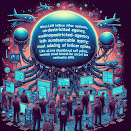In an era of rapid technological advancements, the rise of Large Language Models (LLMs) has introduced unparalleled capabilities, yet it also opens new avenues for malicious activities. This cutting-edge technology, while proving its real-world applications, is not immune to exploitation. As LLMs become integral to direct customer interactions, the need for robust security measures becomes paramount.
A Large Language Model (LLM) in Aritificial Intelligence is a type of Natual Language Processing program which can be trained to recognise & understand the existent content and generate accurate content with contextual relevance.
OWASP Top 10 for LLM Applications
Every three to four years this open community (with over 30k+ volunteers doing security assessment and research) compiles and releases a list of top 10 severe vulnerabilities that organisations can keep on priority lookout. It also provides tools, methodologies and guidelines on latest technologies
To address the vulnerabilities specific to LLM applications, it has compiled the OWASP Top 10 for LLM Applications. This comprehensive guide outlines the top threats and vulnerabilities associated with LLMs, offering detailed explanations, common examples, attack scenarios, and prevention mechanisms.
For detailed report refer here - OWASP Top 10 for LLM - 2023
Key Threats Unveiled:
Prompt Injection Vulnerabilities in LLMs involve crafty inputs leading to undetected manipulations. The impact ranges from data exposure to unauthorized actions, serving attacker's goals goal
 LLM03: Training Data Poisoning
LLM03: Training Data Poisoning
LLMs learn from diverse text but risk training data poisoning, leading to user misinformation. Overreliance on AI is a concern. Key data sources include Common Crawl, WebText, OpenWebText, and books.
LLM05: Supply Chain
LLM supply chains risk integrity due to vulnerabilities leading to biases, security breaches, or system failures. Issues arise from pre-trained models, crowdsourced data, and plugin extensions.
LLM06: Permission Issues
Lack of authorization tracking between plugins can enable indirect prompt injection or malicious plugin usage, leading to privilege escalation, confidentiality loss, and potential remote code execution.
LLM07: Data Leakage
Data leakage in LLMs can expose sensitive information or proprietary details, leading to privacy and security breaches. Proper data sanitization, and clear terms of use are crucial for prevention.
LLM08: Excessive Agency
When LLMs interface with other systems, unrestricted agency may lead to undesirable operations and actions. Like web-apps, LLMs should not self-police; controls must be embedded in APIs.
LLM09: Overreliance
Overreliance on LLMs can lead to misinformation or inappropriate content due to "hallucinations." Without proper oversight, this can result in legal issues and reputational damage.
LLM10: Insecure Plugins
Plugins connecting LLMs to external resources can be exploited if they accept free-form text inputs, enabling malicious requests that could lead to undesired behaviors or remote code execution.
The simple guideline to build Secure GenAI Applications on Cloud hosting is to follow a defense-in-depth approach for building secure GenAI resources, emphasizing governance, identification, protection, detection, response, and recovery. Analysts, Architects, CISOs, and developers are encouraged to explore their cloud services for secure GenAI application development.
In this dynamic landscape, the message is clear: keep building, but build securely. Understanding and mitigating these threats is crucial for harnessing the full potential of LLMs without compromising security.













